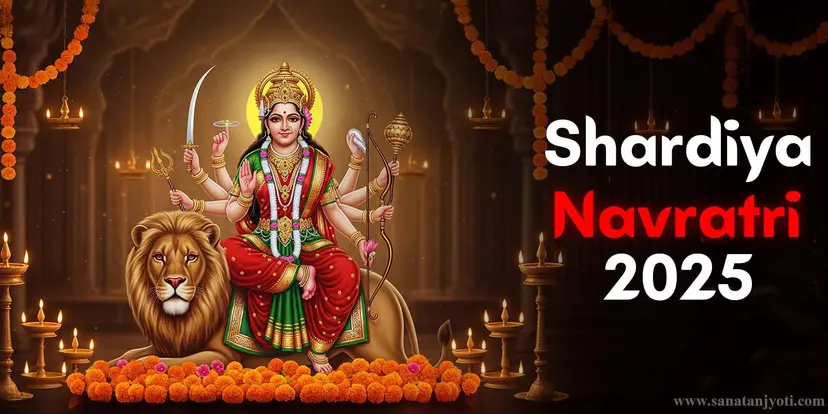Shardiya Navratri is one of the most sacred and important festivals of Sanatan Dharma, celebrated for nine days. The festival is dedicated to the worship of nine different forms of Goddess Durga, who are considered to be the symbols of power, prosperity, and knowledge. Celebrated every year in the Shukla Paksha of the Ashwin month, this Navratri symbolizes the victory of good over evil and spiritual awakening.
When is Shardiya Navratri 2025?
Shardiya Navratri 2025 will begin on Monday, 22 September 2025, and end on Thursday, 2 October 2025. It begins every year on the next day of Pitru Amavasya, on the Pratipada Tithi of Shukla Paksha of the Ashwin month.
Auspicious time for Ghatasthapana
Shardiya Navratri begins with Kalash Sthapana (Ghatasthapana), which is considered extremely auspicious. Selecting an auspicious time is very important for any significant ritual in Sanatan Dharma. It is believed that an action performed at the right time aligns more favorably with cosmic energies, making its outcomes more effective and positive. The muhurat for Ghatasthapana ensures that devotees begin their sadhana when the universe’s energies are most supportive of spiritual efforts.
- Ghatasthapana Muhurat: 22 September 2025, from 6:27 AM to 7:58 AM
- Abhijit Muhurat: 22 September 2025, from 12:07 PM to 12:55 PM
Navratri 2025: Nine Days and Worship of Goddesses
A special form of Maa Durga is worshipped on each day of Navratri. These nine formsrepresent different aspects of power, wisdom and prosperity. The dates of these nine days and the respective deities are as follows:
Shardiya Navratri 2025: Dates and Goddess Worship
- 22 September (Monday) – Pratipada: Maa Shailputri
- 23 September (Tuesday) – Dwitiya: Maa Brahmacharini
- 24 September (Wednesday) – Tritiya: Maa Chandraghanta
- 25 September (Thursday) – Tritiya: Maa Chandraghanta
- 26 September (Friday) – Chaturthi: Maa Kushmanda
- 27 September (Saturday) – Panchami: Maa Skandamata
- 28 September (Sunday) – Shashti: Maa Katyayani
- 29 September (Monday) – Saptami: Maa Kalaratri
- 30 September (Tuesday) – Ashtami: Maa Mahagauri (Maha Ashtami)
- 01 October (Wednesday) – Navami: Maa Siddhidatri (Mahanavami)
- 02 October (Thursday) – Dashami: Vijayadashami & Durga Visarjan
Durga Visarjan and Dussehra
Shardiya Navratri will conclude on 2 October 2025 (Thursday) with Durga Visarjan and Dussehra. On this day, the Navratri fast is broken, and Dussehra is celebrated to symbolize the victory of good over evil.
What is Navratri?
The word “Navratri” combines two Sanskrit words—”Nav” (nine) and “Ratri” (night)—meaning nine nights. These nine nights and ten days are dedicated to the divine feminine energy through the worship of different forms of Maa Durga. These nights allow devotees to move away from worldly distractions and focus on their inner consciousness. This period serves as a structured spiritual retreat, enabling deep sadhana, self-purification, and spiritual awakening. During Navratri, devotees worship Maa Durga to purify the soul, attain inner wisdom, and remove life’s obstacles.
Maa Durga symbolizes strength, courage, and valor. Her worship grants mental and spiritual peace, eliminates obstacles, and fosters self-confidence and bravery to face life’s challenges. This festival is not limited to religious significance alone; it also showcases India’s cultural diversity, observed with different traditions across various states.
Legend of Shardiya Navratri
The legend of Shardiya Navratri originates from the story of Goddess Durga slaying the powerful demon Mahishasura. It symbolizes the triumph of good over evil and the establishment of dharma.
The Terror of Mahishasura: Mahishasura was a powerful demon blessed by Lord Brahma that no man or god could kill him. This boon made him arrogant and tyrannical. Believing that a woman was incapable of defeating him, he launched an attack on heaven, defeated the gods, and took over Indra’s throne, causing havoc in all three worlds.
Manifestation of Goddess Durga: When the gods found no way to defeat Mahishasura, they approached Brahma, Vishnu, and Mahesh. The combined divine energies of all deities created a radiant and powerful feminine form—Goddess Durga. Each god bestowed her with their weapons and powers, preparing her for battle.
Killing of Mahishasura: Goddess Durga battled Mahishasura for nine days. This was more than a physical battle; it represented the struggle between righteousness and evil, knowledge and ignorance. Despite Mahishasura’s ability to change forms, Maa Durga vanquished him in every form. On the tenth day, she killed him with her divine trident,restoring peace to the world.
Symbolic Significance: “Mahishasura Mardini” means the one who slayed Mahishasura. This is more than a myth—it is a metaphor for conquering inner evils like ego, ignorance, greed, and attachment.It emphasizes that the greatest challenges lie within and overcoming them requires inner strength. Maa Durga represents the immense power within every woman—gentle, yet powerful, decisive, and transformative. Navratri is a reminder to conquer our inner Mahishasura and uphold truth and conscience.
Shardiya Navratri Puja Vidhi
The pujas and rituals performed during Shardiya Navratri are extremely elaborate and symbolic, helping devotees achieve maximum alignment with divine energy. The complexity and uniqueness of these rituals are not just traditions, but they are based on deep symbolism and energy science.
A. Detailed Method of Kalash Installation
Kalash Sthapana, the first and most important ritual of Navratri, marks the beginning of the nine-day festival. It is very important to do it correctly:
1. Purification and preparation: On the first day of Navratri, wake up in the Brahma Muhurta, take a bath and wear clean clothes. Purify the entire house, especially the place of worship by sprinkling Ganga water. Decorate the arch of mango leaves on the door frame of the main door, which is a symbol of auspiciousness.
2. Chowki and Idol Installation: Install a clean wooden post in the north or north-east direction at the place of worship. According to Vastu Shastra, this direction is considered to be the most auspicious for the flow of energy, which transmits positive energy. Install a statue or picture of Maa Durga on this outpost. If possible, keep a statue of Maa Shailputri as she is the first worshipped goddess. Sow clean soil and barley seeds in a clay pot (or wide-mouthed container). Place this container near the post. Barley is considered a symbol of prosperity and new life.
3. Installing the urn: Wash a copper or clay urn thoroughly and make a swastika mark on it and apply vermilion tika. Wrap the moli (sacred thread) around the neck of the vase.
Fill the urn with pure water or Ganga water. Add a betel nut, a few coins, durva grass, a lump of turmeric and akshat (whole rice) to it. All these materials symbolize prosperity, purity, and obstacle prevention.
Place five mango leaves on the mouth of the urn. Wrap a coconut in a red cloth and tie a kalwa on it and place it on top of the mango leaves in such a way that it faces upwards. Coconut is considered a symbol of perfection and auspiciousness. Install this prepared urn on or near an earthen pot sown with barley. Many devotees also light a monolithic lamp along with Kalash Sthapana, which burns continuously for nine days and symbolizes knowledge and light.
4. Invocation of Mother Earth: Touch the soil that has been spread under the urn with your right hand and chant this mantra:
“Om bhurasi bhumirasya aditirasi vishvadhaya vishvasya bhuvanasya dhartrim.Prithivim yachchha prithivim drigvanga ha prithivim ma hi gvanga sih.”
Meaning- O Mother Earth, you sustain all life. You hold the weight of the three worlds. Remain firm and keep us grounded. Grant strength, health, and remove our pain and suffering. Be our eternal support. This mantra seeks stability and strength from Mother Earth.
B. How to perform daily puja rituals in nine forms of Maa Durga
During the nine days of Navratri, Goddess Durga is worshipped in the morning and evening. This daily puja provides devotees with the opportunity to connect with the specificenergies and qualities of each Goddess:
Light a lamp every morning and evening. Offer akshat, vermilion and red flowers on the statue or picture of the mother. Offer fruits and offerings. Recite Durga Saptashati, Devi Mahatmya, or Gayatri Chalisa. At the end, perform the aarti of the mother and distribute the prasad to all.
C. Kanya Pujan: Importance and Ritual Method
Kanya Pujan is one of the most important rituals of Navratri, which will be performed on 01 October 2025 or 02 October 2025 in Shardiya Navratri 2025.
In this, nine small girls are worshiped as the incarnation of the Mother Goddess, and along with them, a boy is also worshiped as Bhairav. This ritual depicts the complementary aspect of Shiva (Bhairav) with Shakti, which symbolizes perfection and balance.
1. Invitation and Welcome: Respectfully invite 9 girls and one boy for Kanya Pujan. Make them sit reverently in a clean place.
2. Purification and Tilak: Purify the feet of all the girls and boys by washing them with clean water. After this, apply Roli and Akshat tilak on their forehead.
3. Pooja and Aarti: Worship and Aarti as a symbol of Maa Durga. If you want, you can also paint the feet of the girls with color and cover them with chunri.4. Bhog and food: Prepare satvik bhog of halwa, puri, chana, kheer and fruits. Keep in mind that garlic and onion should not be used in it at all. First of all, offer the same bhog to the mother queen, then serve the same bhog to the girls.
5. Gifts and Blessings: After the meal, give gifts and dakshina as per your reverence. Now touch the feet of the girls and Bhairav, take blessings from them and send them offrespectfully.
By worshipping the girl, Goddess Durga is very happy, all the wishes of the devotees are fulfilled, and happiness and prosperity come to the family.
Shardiya Navratri Mantra Chanting and Its Benefits
Mantra chanting is an integral part of Navratri sadhana. Mantras are not just repetition of words, but they are a powerful means of focusing consciousness through sound vibrations and attracting specific divine energies. These are often called ‘beej mantras’, in which lies the power of cosmic sounds. When these sounds are repeated, they produce specific vibrations in the body and mind, which affect the individual’s consciousness and align with the cosmic energies. It is not just a prayer, but a kind of ‘energy engineering’, which provides devotees with a means to modify their inner energy and influence the outer reality.
Specific mantras of each goddess
The chanting of mantras specific to each Goddess attracts her special energies and qualities, as mentioned in the Puja Vidhi section above.
Spiritual and Personal Benefits of Mantra Chanting
Mantra chanting has many deep benefits:
· It increases concentration and reduces stress.
· Positive energy is transmitted and confidence increases.
· It helps in removing obstacles in career.
· Success and prosperity are achieved.
Rules of Mantra Chanting
It is important to follow a few rules to get the most out of mantras:
· Keep positive thoughts in mind while chanting.
· Sit in front of the idol or picture of Goddess Durga and chant.
· Chant with a Rudraksha or Tulsi beads.
· Chant at least 108 times daily.
Navratri Mantras, Deities and Their Benefits
1. Om Aim Hreem Kleem Chamundayai Vichche
· Deity: Navarna Mantra (Maa Durga)
· Benefit: Removal of obstacles, self-confidence, career success.
2. Om Dum Durgayai Namah
· Deity: Maa Durga
· Benefit: Boosts confidence, destroys negative energies.
3. Om Bhur Bhuvah Swah Tatsavitur Varenyam Bhargo Devasya Dheemahi Dhiyo Yo Nah Prachodayat
· Deity: Gayatri Mata
· Benefit: Wisdom, intellect, concentration.
4. Om Shreem Mahalakshmyai Namah
· Deity: Maa Lakshmi
· Benefit: Wealth, prosperity, financial growth.
5. Om Sarasvatyai Namah
· Deity: Maa Saraswati
· Benefit: Knowledge, creativity, artistic success.
6. Om Shailaputryai Devyai Namah
· Deity: Maa Shailputri
· Benefit: Strength and stability.
7. Om Brahmacharinyai Namah
· Deity: Maa Brahmacharini
· Benefit: Discipline, penance, detachment.
8. Om Chandraghantayai Namah
· Deity: Maa Chandraghanta
· Benefit: Courage, fearlessness.
9. Om Kushmandayai Namah
· Deity: Maa Kushmanda
· Benefit: Health, vitality, cosmic energy.
10. Om Skandamatayai Namah
· Deity: Maa Skandamata
· Benefit: Motherly love, blessings of children.
11. Om Kaalratryai Namah
· Deity: Maa Kaalratri
· Benefit: Victory over enemies, removal of marriage obstacles.
12. Om Mahagauryai Namah
· Deity: Maa Mahagauri
· Benefit: Peace, purity, destruction of negativity.
13. Om Siddhidatryai Namah
· Deity: Maa Siddhidatri
· Benefit: Attainment of siddhis, fulfillment of desires.
Difference Between Chaitra Navratri and Shardiya Navratri
- Chaitra Navratri is celebrated in spring (March-April), while Shardiya Navratri is celebrated in autumn (September-October).
- Chaitra Navratri coincides with the beginning of the Indian New Year, Shardiya Navratri marks the beginning of autumn.
- The festival of Ram Navami is celebrated on the last day of Chaitra Navratri, while Shardiya Navratri ends with Dussehra.
- During Chaitra Navratri, trees and plants produce new leaves and flowers, while during Shardiya Navratri, there is dryness and cold air in the trees.
- Chaitra Navratri is the time for sowing the new crop, while Shardiya Navratri is the time for harvesting and harvesting of the crop.
Frequently Asked Questions (FAQs)
1. Why do we celebrate Shardiya Navratri?
Shardiya Navratri marks the slaying of Mahishasura by Maa Durga and the victory of good over evil. Itis a festival of strength, courage and spiritual purification, which brings spiritual awareness and prosperity.
2. What to do in Shardiya Navratri?
Perform Kalash installation in Shardiya Navratri, worship the nine forms of Maa Durga for nine days with rituals, chant mantras, recite Durga Saptashati, eat satvik food, do charity, and worship Kanya on Ashtami / Navami.
3. How to do Shardiya Navratri at home?
· Clean the place of worship thoroughly.
· Establish the urn at an auspicious time.
· Install a statue or picture of Maa Durga.
· Worship nine goddesses every day.
· Light a lamp and offer bhog.
· Perform aarti regularly and chant mantras.
· Follow the Sattvic rules throughout the fasting period.
4. How to worship Shardiya Navratri?
· Take a bath in the Brahma Muhurat and wear pure clothes.
· Clean the place of worship and purify it with Ganga water or holy water.
· Establish the urn at an auspicious time.
· Install a statue or picture of Maa Durga.
· Worship the nine forms of Maa Durga for nine days – Akshat, vermilion, flowers, fruits, sweets etc.
· Perform aarti by lighting a lamp daily and chant mantras.
· Recite Durga Saptashati or Devi Mahatmya.
· Perform Kanya Puja on Ashtami or Navami.
· Follow a sattvic lifestyle and moderation throughout the fasting period.
5. When will Shardiya Navratri 2025 begin?Shardiya Navratri 2025 will begin on Monday, 22 September 2025. On this day, Ghatasthapana is performed on the Shukla Pratipada date of Ashwin month, which begins the auspicious day of worship of Goddess Durga. Theauspicious time of Ghatasthapana (Kalash Sthapana) will be from 6:27 am to 7:58 am on 22 September 2025. Shardiya Navratri is celebrated for a total of nine days and culminates on Dashami Tithi with the Vijayadashami(Dussehra) festival, which will be celebrated on 2nd October 2025 in the year 2025. This festival is considered a symbol of power worship, spiritual purification and victory of good over evil.
6. What not to do in Shardiya Navratri?
· Do not consume tamasic and intoxicating substances etc.
· Do not cut hair, nails, and beards (especially for fasting people).
· Do not bring leather items to the place of worship.
· Do not allow an atmosphere of quarrel, discord or impurity in the house.
· Do not sleep during the day during the fast – This is considered a violation of the fasting rules.
· Stay away from impure and indecent thoughts and keep pure conduct.
7. What to do on the day of Shardiya Navratri?
· Worship the nine forms of Maa Durga every day.
· Chant and recite the mantras of each goddess.
· Observe a fast (if possible) and eat sattvic food.
· Keep the place of worship clean and light a lamp daily.
· Offer bhog and perform aarti.
· Recite Durga Saptashati or Devi Mahatmya.
· Keep the atmosphere of the house positive and peaceful.
· On the day of Ashtami or Navami, Kanya Puja must be performed.
· Donate and help the needy.
Source URL:
https://www.sanatanjyoti.com/articles/shardiya-navratri-2025-28






